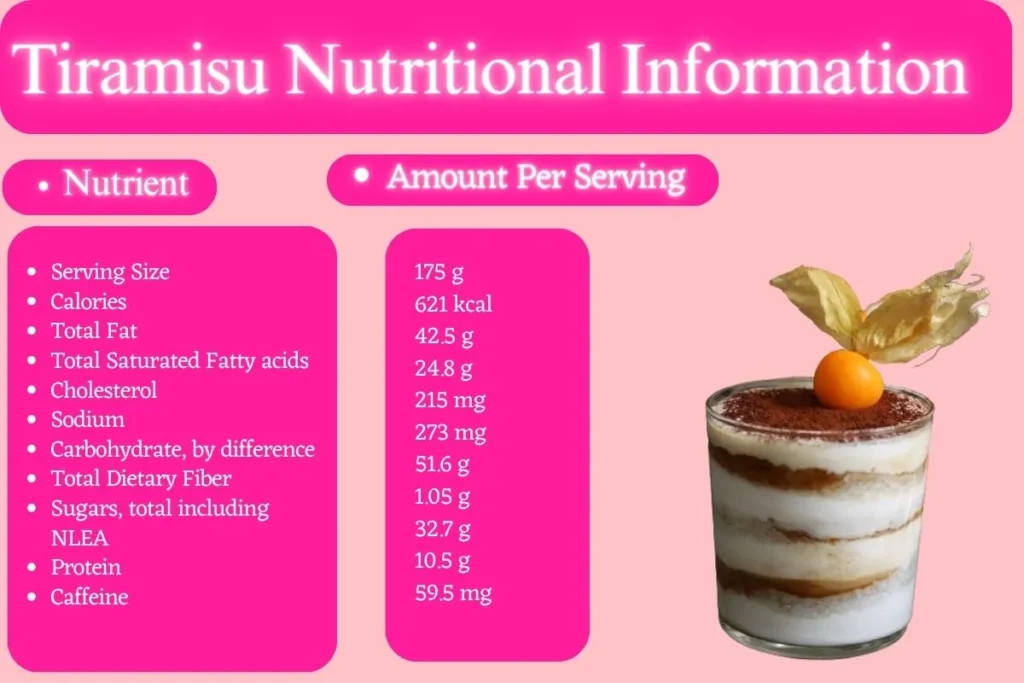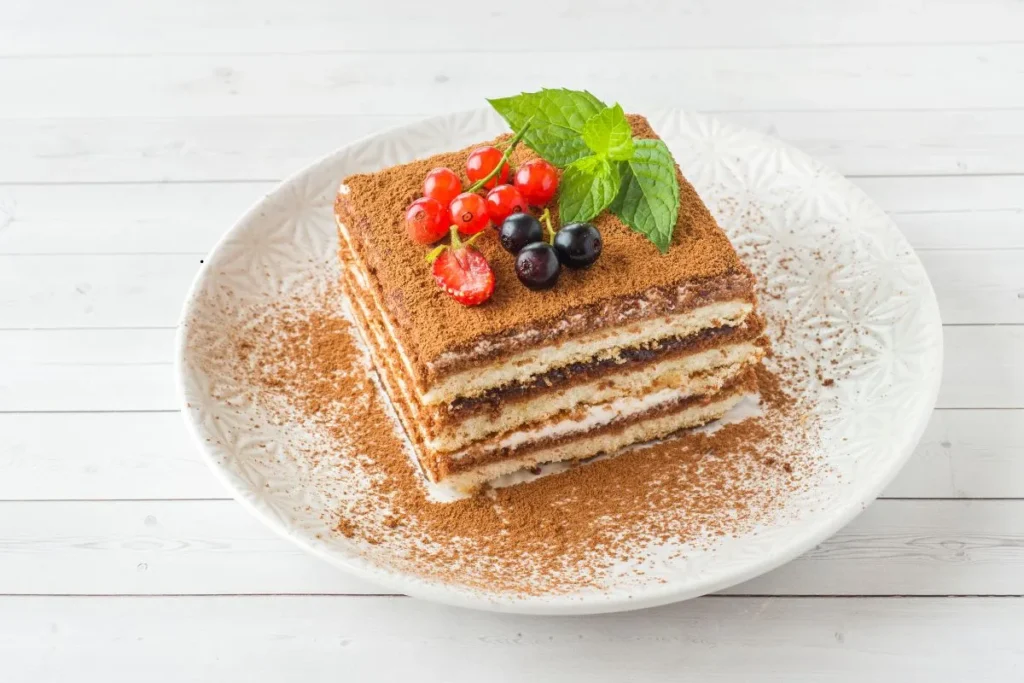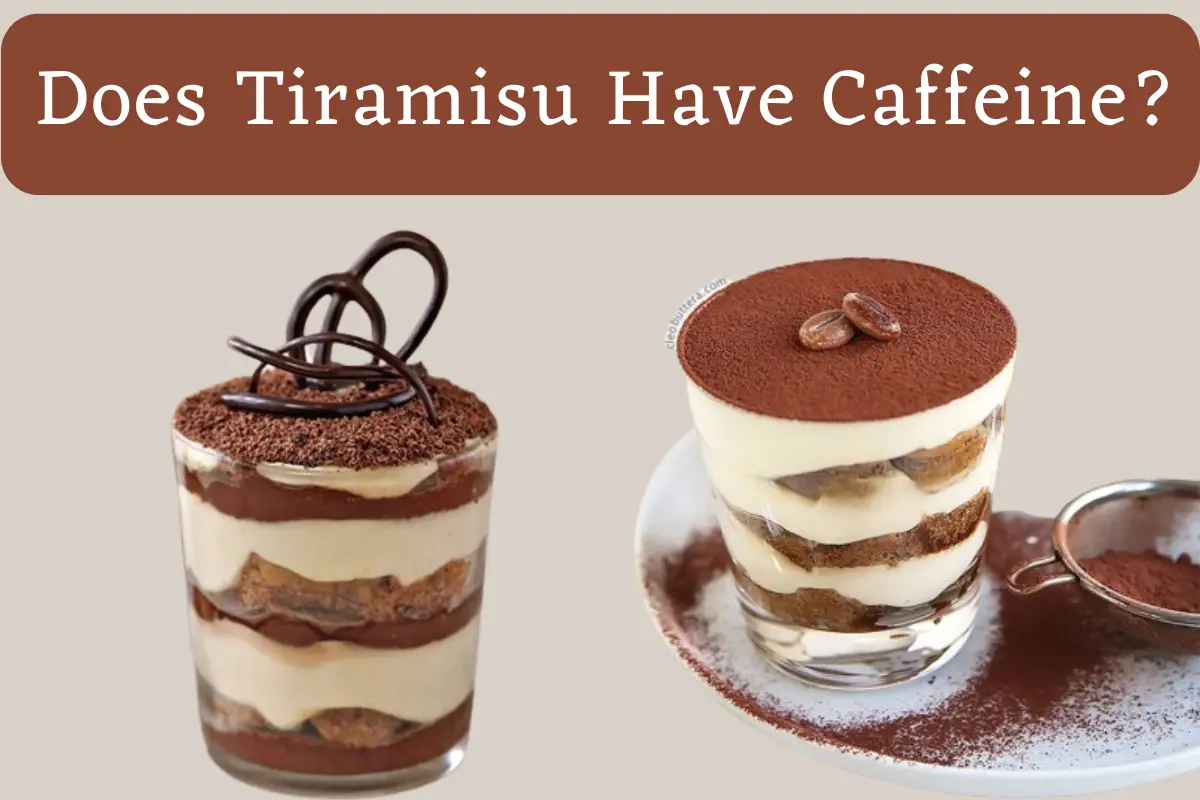Did you know the classic Italian dessert Tiramisu literally means “pick me up”? This name hints at the dessert’s stimulating nature. With its layers of coffee-soaked ladyfingers and rich, creamy filling, this treat delivers a delightful energy boost. Naturally, that leads us to wonder – does Tiramisu have caffeine?
If you’re sensitive to caffeine, want to savor a late-night slice without staying awake, or simply love learning about your favorite foods, let’s dive into the caffeinated side of this beloved Italian indulgence.
Importance of Knowing About Tiramisu
Tiramisu’s global popularity makes understanding its caffeine content important. This decadent dessert is enjoyed in cafes and homes worldwide, from intimate gatherings to special occasions.
While the coffee element offers a delightful flavor boost and a touch of energy, it’s crucial to be aware of how much caffeine you might be consuming.
There’s a common misconception that Tiramisu contains a negligible amount of caffeine, but this isn’t always accurate. The caffeine content in Tiramisu can vary based on factors like the strength of the coffee used, the amount of espresso in the recipe, and serving size.
For those sensitive to caffeine, those avoiding it for health reasons, pregnant women, or individuals enjoying a late-night treat, knowing Tiramisu’s potential caffeine kick is essential to make informed choices about consumption.
Does Tiramisu Have Caffeine?
Traditional Tiramisu recipes absolutely include a source of caffeine: coffee, typically in the form of a strong espresso. The ladyfinger cookies are dipped in this coffee, absorbing its flavor and caffeine content. While recipes can vary, it’s safe to say that a standard portion of Tiramisu will contain a noticeable amount of caffeine.
The caffeine punch in your Tiramisu depends on several things:
- Coffee Strength: A stronger espresso brew means more caffeine in your dessert.
- Soaking Time: The longer the ladyfingers soak in the coffee, the more caffeine they’ll absorb.
- Serving Size: Naturally, a larger slice of Tiramisu equates to a bigger caffeine dose.
Some people assume that the cooking process in Tiramisu eliminates the caffeine from the coffee, but this isn’t true. Caffeine is relatively stable under heat, so a significant amount remains in the dessert.
If you love the indulgence of Tiramisu but want to avoid the caffeine kick, there are options:
- Decaf Delight: Substitute regular espresso with decaffeinated coffee.
- Fruity Twist: Many delicious Tiramisu variations exist, replacing coffee with fruit purees or liqueurs.
- Coffee-Free Alternatives: Recipes like chocolate Tiramisu offer a similar richness without the caffeine.
According to USDA, a 175 grams piece of Tiramisu contains 59.5 mg caffeine.
Tiramisu Variants and their Caffeine Content
Tiramisu has inspired numerous variants, each offering a unique twist on the original recipe. Here are some popular tiramisu variants:
Chocolate Tiramisu
This variation incorporates chocolate into the traditional recipe, either by adding cocoa powder to the mascarpone mixture or layering chocolate shavings between the ladyfingers. Cocoa powder typically contains a small amount of caffeine, usually around 12 milligrams per tablespoon. However, the amount used in chocolate tiramisu may vary depending on the recipe, so the caffeine content would be relatively low.
Fruit Tiramisu
In this variant, fresh or macerated fruits such as berries, peaches, or mangoes are added between the layers of mascarpone and ladyfingers, adding a refreshing and fruity flavor to the dessert. Since fruits themselves do not contain caffeine, this variation would have minimal to no caffeine content unless caffeinated ingredients are added separately.
Tiramisu Cheesecake
Combining the flavors of tiramisu with the creamy texture of cheesecake, this variant features a traditional tiramisu filling atop a graham cracker or chocolate cookie crust. Like the traditional tiramisu, the caffeine content in tiramisu cheesecake would come from the espresso-soaked ladyfingers, typically around 30-50 milligrams per serving depending on the recipe and the strength of the espresso.
Nutella Tiramisu
Nutella, a popular hazelnut chocolate spread, is incorporated into the mascarpone mixture or spread between the layers of ladyfingers, adding a rich and indulgent flavor to the dessert. Nutella contains a small amount of caffeine due to the cocoa content, but it’s usually negligible in the context of a tiramisu dessert.
Vegan Tiramisu
Catering to plant-based diets, vegan tiramisu substitutes ingredients such as coconut cream or cashew cream for the traditional mascarpone cheese and uses dairy-free alternatives for eggs and milk. The caffeine content in vegan tiramisu would depend on the type of coffee substitute used in place of espresso. For example, if using a coffee alternative like chicory or dandelion root, there may be little to no caffeine. However, if using a coffee substitute like decaf coffee, there would still be some residual caffeine, typically around 2-5 milligrams per 8-ounce serving.
Pumpkin Spice Tiramisu
Perfect for the fall season, this variant adds pumpkin puree and warm spices such as cinnamon, nutmeg, and cloves to the mascarpone mixture, creating a cozy and flavorful dessert. Similar to the chocolate tiramisu, the caffeine content in pumpkin spice tiramisu would be minimal unless coffee or espresso is used in the recipe.
Matcha Tiramisu
Inspired by Japanese flavors, matcha powder is added to the mascarpone mixture or dusted over the cocoa powder, infusing the dessert with a subtle green tea flavor and vibrant color. Matcha contains caffeine, but the amount used in tiramisu recipes is usually relatively small, providing around 30-40 milligrams of caffeine per teaspoon of matcha powder.
Lemon Tiramisu
Bright and refreshing, lemon zest or lemon curd is incorporated into the mascarpone filling, adding a zesty citrus twist to the traditional dessert. Unless caffeinated ingredients are added separately, lemon tiramisu would have minimal to no caffeine content.
List of Ingredients in Tiramisu
Here’s a breakdown of the ingredients used in classic Tiramisu:
Core Components
- Ladyfingers (Savoiardi): These oblong-shaped sponge cookies are incredibly light and airy, with a slightly sweet flavor. Their porous texture is ideal for absorbing the rich coffee mixture, becoming the tender base of the dessert.
- Espresso: Tiramisu derives its characteristic flavor and energy boost from a strong espresso. The coffee should be freshly brewed and intensely flavored to stand out against the creamy sweetness of the other components.
- Mascarpone Cheese: This Italian cream cheese is essential for the decadent filling. Mascarpone is incredibly rich, with a silky texture and a slightly tangy flavor that balances the sweetness of the dessert.
- Egg Yolks: Egg yolks are used for both their thickening properties and the lushness they add to the filling. Beaten with sugar, they create a light and airy base for the mascarpone.
- Sugar: Granulated sugar provides necessary sweetness to counterbalance the slight bitterness from the coffee and cocoa powder. The amount of sugar can be adjusted based on your preferences.
- Cocoa Powder: Unsweetened cocoa powder is the quintessential topping for Tiramisu. It offers a slightly bitter contrast to the sweet filling and adds a beautiful visual finish.
Optional Additions
- Marsala Wine or Rum: A touch of Marsala wine, a sweet fortified wine from Sicily, or a dark rum can be added to the coffee mixture. This gives the Tiramisu an extra depth of flavor and a subtle boozy kick.
- Heavy Cream: Sometimes, whipped heavy cream is gently folded into the mascarpone mixture. This creates a lighter, even airier filling with a beautifully luxurious texture.
Tiramisu Nutritional Information

A 175g serving of Tiramisu packs a substantial nutritional punch. With 621 calories, it’s a decadent treat best enjoyed in moderation. It contains a high amount of fat (42.5g), with a significant portion (24.8g) being saturated fat. Tiramisu also contains 215mg of cholesterol, which is a considerable amount.
On the other hand, it provides 51.6g of carbohydrates, with only a small amount (1.05g) coming from dietary fiber and 32.7g from sugars. Tiramisu does offer 10.5g of protein. Finally, a standard serving of Tiramisu contains 59.5mg of caffeine, giving it that characteristic energy-boosting quality.
| Nutrient | Amount Per Serving |
| Serving Size | 175 g |
| Calories | 621 kcal |
| Total Fat | 42.5 g |
| Total Saturated Fatty acids | 24.8 g |
| Cholesterol | 215 mg |
| Sodium | 273 mg |
| Carbohydrate, by difference | 51.6 g |
| Total Dietary Fiber | 1.05 g |
| Sugars, total including NLEA | 32.7 g |
| Protein | 10.5 g |
| Caffeine | 59.5 mg |
Alternatives to Tiramisu and their Caffeine Content
If you’re looking for alternatives to tiramisu that have varying levels of caffeine content, here are some options:
Panna Cotta
A classic Italian dessert made with sweetened cream and milk, flavored with vanilla or other flavorings. It does not contain any caffeine, making it a great option for those looking to avoid caffeine altogether.
Crème Brûlée
This rich custard dessert with a caramelized sugar topping is another caffeine-free option. It’s a perfect choice for those who want an indulgent dessert without the stimulating effects of caffeine.
Affogato
A dessert made by pouring a shot of hot espresso over a scoop of vanilla gelato or ice cream. The caffeine content depends on the amount of espresso used, but it typically contains a moderate amount of caffeine, making it a suitable option for those who enjoy a little caffeine kick.
Mocha Mousse
A light and airy chocolate mousse flavored with espresso or coffee. The caffeine content can vary depending on the amount of espresso or coffee used, but it generally contains a moderate amount of caffeine, similar to the affogato.
Coffee Crunch Cake
A layered cake made with coffee-flavored sponge cake, coffee buttercream frosting, and a crunchy coffee-flavored topping. This dessert typically contains a high amount of caffeine due to the presence of concentrated coffee flavors, making it a great choice for those who love a strong coffee flavor and don’t mind the caffeine boost.
Espresso Brownies
Rich, fudgy brownies infused with espresso or coffee. The caffeine content can be moderate to high, depending on the amount of espresso or coffee used. These brownies offer a chocolatey treat with a coffee twist and a potential caffeine kick.
Café Liégeois
A French dessert consisting of coffee-flavored ice cream topped with whipped cream and a shot of hot espresso or coffee. The caffeine content can be moderate to high, depending on the amount of espresso or coffee used. This dessert combines the richness of ice cream with the bold flavor of coffee, making it a decadent option for coffee lovers.
| Dessert | Caffeine Content |
| Panna Cotta | None |
| Crème Brûlée | None |
| Affogato | Moderate |
| Mocha Mousse | Moderate |
| Coffee Crunch Cake | High |
| Espresso Brownies | Moderate to High |
| Café Liégeois | Moderate to High |
Recommended Daily Intake of Tiramisu

A 175-gram serving of Tiramisu packs a caffeine punch of roughly 59.5mg. While this is below the recommended daily intake of 400mg for most adults, it’s still a considerable amount. That single serving equates to about 15% of your daily caffeine allowance. If you’re sensitive to caffeine, have multiple servings in a day, or are pregnant, Tiramisu’s caffeine content is something to consider.
Those who find caffeine disrupts their sleep should probably avoid this treat as a late-night indulgence. It’s important to remember that Tiramisu recipes vary, so the caffeine content can change slightly. Naturally, a smaller serving size will contain less caffeine.
Conclusion
Does Tiramisu Have Caffeine? Tiramisu does indeed contain caffeine. While the exact amount varies based on recipes and serving sizes, it’s safe to say this decadent dessert isn’t a caffeine-free indulgence. For those with caffeine sensitivities, those avoiding caffeine for health reasons, or anyone enjoying a slice close to bedtime, it’s essential to be aware of this fact.
However, there’s no need to avoid Tiramisu altogether! Simply enjoy it in moderation, consider opting for a smaller serving, or explore the delicious world of decaf or fruit-based variations for a caffeine-free treat with the same delightful spirit.
FAQs
Q1: Does tiramisu contain coffee?
Yes, traditional tiramisu recipes include coffee, typically in the form of a strong espresso. The ladyfinger cookies are soaked in this coffee, which is where the dessert gets its signature flavor and caffeine content.
Q2: Can I make tiramisu without caffeine?
Absolutely! You can easily make caffeine-free Tiramisu by substituting the espresso with decaffeinated coffee. Additionally, many wonderful fruit-based variations replace the coffee element with fruit purees or liqueurs.
Q3: Are there any health benefits to consuming tiramisu?
Tiramisu is primarily considered a decadent dessert rather than a health food. It’s high in calories, fat, and sugar. However, it does contain some protein and calcium due to the mascarpone cheese and egg yolks. Enjoying Tiramisu in moderation is the key.
Q4: Is there alcohol in tiramisu?
Some Tiramisu recipes include alcohol, typically Marsala wine or a dark rum. This is added to the coffee mixture for extra depth of flavor. However, there are plenty of alcohol-free Tiramisu recipes available as well.
Q5: Why is tiramisu so popular?
Tiramisu’s immense popularity stems from several factors. Its creamy, dreamy texture contrasted with the slight bitterness of coffee and cocoa creates a delightful balance of flavors. It’s beautifully simple to assemble yet feels incredibly indulgent. Plus, the endless possibilities for variations, from classic to creative, make it suitable for a wide range of palates.

Rossi Glover, the passionate Owner of Grand Lake Coffee, infuses every cup with her love for coffee and dedication to quality. With an extensive background in the art and science of coffee, Rossi is not just a connoisseur but a storyteller, sharing the intricate tales behind each brew.

